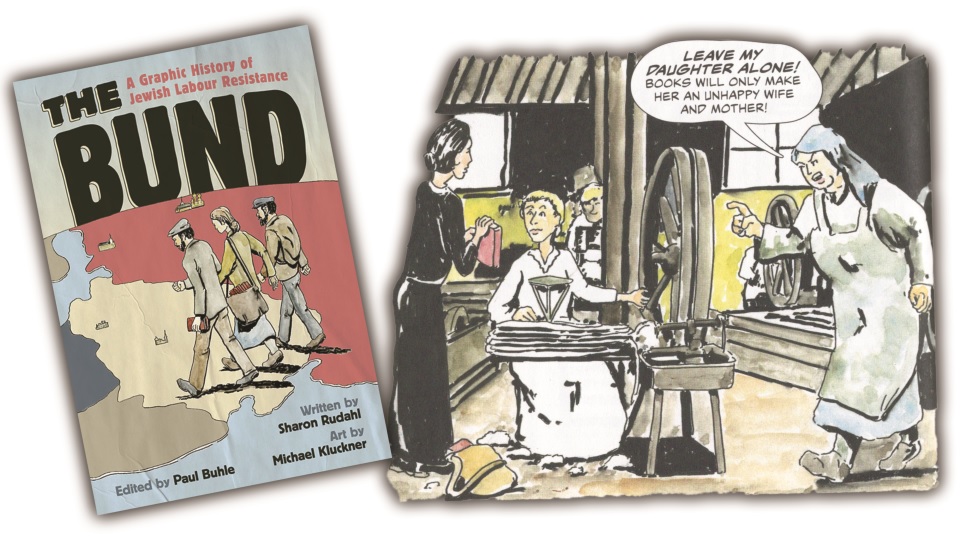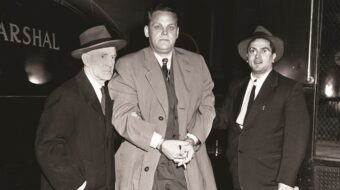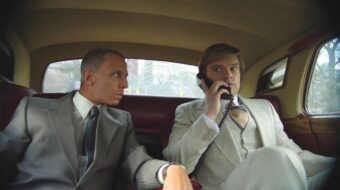
Dismissed today in establishment Jewish history—and one could say in history period—the Jewish Labor Bund, a movement founded in 1897 and still extant in vestigial form, played a critical role during the years of its highest influence in the first four decades of the 20th century.
The Bund: A Graphic History of Jewish Labour Resistance has just appeared in print, a comic book treatment of a wide-ranging and difficult subject. The Bund is no great mystery to serious students of modern Jewish history, though a full understanding of its achievements may still be limited to those who can read Yiddish, the language most Jews spoke and in which the Bund conducted its affairs.
Powerful historical tides, however, beginning around World War I and the Russian Revolution and ending in the 1940s with the murder of a third of the world’s Jewish population and the establishment of the State of Israel, swept the Bund into permanent obsolescence.
Yet its promise, its goals, and the successes it racked up in its short life are still worthy of examination, and there is much young people can learn from its legacy.
The Bund was an avowedly socialist organization of the Jewish people in Central and Eastern Europe, inspired by Marxist thought. Curiously, in the same year it was founded, the Zionist movement inspired by Austrian journalist Theodor Herzl, also saw its founding convention. Thus the contours of Jewish possibility were laid out.
Three great options presented themselves to the Jews of Europe, the greatest number by far living under the rule of the Russian Tsar in what was referred to as “The Pale of Settlement,” that broad strip of territory between the Baltic and the Black Seas comprising great cities such as Vilna (Vilnius) in the north, Warsaw and Kiev, and Odessa in the south. These lands were all part of the Russian Empire in what are today Lithuania, Poland, Belarus, Ukraine, and Western Russia. With few exceptions, Jews were forbidden to own land or to reside in other parts of the empire, including the major cities of Moscow and St. Petersburg.
The three options included emigration, Zionism, and remaining in place to fight for a better life for Jews and all other people under socialism. Emigration, as we know, was what millions chose. Starting in the 1880s, wave after wave of emigrants fled Russia—and the Tsar’s armies and the constant pogroms and discrimination—and made new lives for themselves in the United States, Western Europe, and in Mexico, Cuba, South America, and elsewhere. Most American Jews trace their lineage to these immigrants.
Zionism was something of a pipe dream at first, and few Jews embraced it. It was the aspiration for a Jewish nation—possibly in Palestine, where the Jewish people first emerged, but maybe somewhere else, in Africa, Australia, or anywhere land could be set apart for them. It was part of the larger 19th-century nationalist movement where the Czechs, Poles, Hungarians, and many other peoples sought to claim their lands for themselves independently, not to be subsumed under the rule of the Russian or Astro-Hungarian empires. The establishment of the State of Israel in 1948 was no great act of global philo-Semitism, but rather the world’s compensation for its own inability to prevent the tragedy of European Jewish loss and displacement during fascism and war. The surviving Jews had virtually nowhere else to go—who would take them in? So why not allow them to occupy their historical lands, despite the patent reality that other people—Palestinians—were now living on it? The magnanimous United Nations approved the Jewish state over strident objections from the Arab states that had already seen Jewish immigrants displacing both Muslim and Christian Arabs from their homes and lands.
That leaves the idea of staying in Russia, in Poland, in Lithuania, Ukraine, and Belarus—a choice most Jews opted for—but also fighting for equality, education, democracy, religious and cultural autonomy, and the right to educate children in Yiddish; in short, for socialism, but not for nationhood or territory. The Bund argued for their philosophy of doikayt. The Yiddish word do (pronounced “doh”) means “here,” and kayt is the suffix for “-ness,” in other words, “hereness,” or “presentness.” Today’s language might suggest: “Be here now.” Why seek out a future in some far land when your whole existence, your people, your language, are right here?
Which is not to say that all the remaining European Jews endorsed the Bund. But the Bund did stand up for the communal rights of all Jews, everywhere, whether or not they considered themselves secularist and socialist.
Sharon Rudahl is a longtime illustrator of comic book histories, but here turns to the role of writer to tell this story, assigning the artistic duties to the gifted Michael Kluckner. The longtime promoter of comic book history Paul Buhle served here as editor.
Representing a stateless, landless people, the Jewish Bundists argued for a world without borders, where workers, students, professionals, everyone could freely move about in search of a better life. As industrialization and urbanization picked up their pace toward the end of the 19th century, cities, such as Łódź, for example, became magnets for rural Jews seeking jobs, advancement, education, and escape from the confining strictures of the traditional shtetl. There they soon found oppressive exploitation of their labor and started resisting. Effective leaders emerged whom the movement never elevated into heroes to be adulated. Arrests, trials, imprisonment, exile to Siberia, were the common lot of those who fell into the maw of the Russian imperial state.
The story of the Bund cannot, of course, be separated out from the massive currents passing across the continent, particularly the rise of the socialist movement in general. The Bund allied itself with the Polish Socialist Party, whose main demands included that for Polish independence, and the Russian Social Democratic Workers Party (RSDWP), in which V.I. Lenin was active. Though some might contest Rudahl’s succinct account, she tells how the Mensheviks and the Bolsheviks emerged within the RSDWP. It involves the Bund:
“At the 1903 2nd RSDWP Conference, brilliant tactician V.I. Lenin manoeuvered to place the Bund’s request to be the sole representative of Jewish workers first on the agenda. He knew it would be voted down, and the Bundists would walk out. In Russian, ‘Bolshevik’ means majority, and ‘Menshevik’ means minority. With the Bund’s votes eliminated, the moderates became the Menshevik minority and Lenin’s more hard-line Bolsheviks, the majority.”
In such a brief book there is no room for historiographical nuance and speculation. But the question could be asked if the Bund’s request was formulated correctly or was even politically or organizationally advisable. It shows, however, the Bundists’ fierce will not to assimilate into the larger Christian world, nor even into the smaller, secular socialist movement where a Jewish presence might disappear. And their insistence on Yiddish as the national Jewish language might have been misplaced. These positions must have grated against the discipline of “democratic centralism” adopted by Communist parties. Almost as soon as the Revolution occurred, dissidents and detractors were dealt with severely as a means of protecting the fragile young state still under attack from both inside and out, and the Bund was shortly banned in the new Soviet Union. Two important Bund leaders, Henryk Erlich and Victor Alter, were liquidated by the Soviets. Human and civil rights in the Western civil libertarian sense were a distant luxury in a land that had never experienced any form of democracy.
The Bund devotes considerable space to the Russo-Japanese War and the 1905 Revolution, the Russian Duma, World War I, continued ethnic and labor repression and the coming of Nazism. Now that the Bund could no longer operate in the USSR, its field of action was reduced largely to Poland and the independent Baltic countries. Though their overall numbers were reduced, the Bund’s influence in Poland reached its apogee. This interwar period, showing what a socialist Jewish organization could accomplish within the larger national entity, unfortunately receives less treatment than it should. Where there were elections, the Bund captured municipal council positions and most of the parliamentary seats allotted to the Jewish minority. The Bund established day schools and trade schools, summer camps, hospitals, orphanages, sports clubs, literary and musical societies, film production, theater groups, a healthy press, and more, all in close allyship with other socialists. And it should be remembered, too, that not all Jews spoke Yiddish and may have chosen to be active in other circles.

The antagonism between socialists and communists grew into a chasm beginning in the first decades of the 20th century. It’s perhaps the greatest tragedy in history that with these two powerful movements at each other’s throats—and for understandable reasons on both sides!—the path was left open for fascism to advance. This awful lesson, the most important one even down to our own times, could have been better underlined for today’s readers.
In America, Bundists allied with the Workmen’s (now Workers) Circle/Arbeter Ring as the closest expression of autonomous socialist and Jewish life, although, unlike the Bund, it was not a political party. Contributors toward this book’s production came from the Toronto Workmen’s Circle/Arbeiter Ring, the Bay Area Workers Circle, and the Democratic Socialists of America Fund, among others.
For what will be for many readers their first exposure to the subject, The Bund is a good start. For further reading, the book includes a short bibliography listing seven book titles and a link to the Bund archive at the YIVO Institute for Jewish Research in New York City. Three Bundists who came to the New World are highlighted in individual mini-biographies—Moishe (Michael) Lewis in Canada, and Charney Vladek and Pesach (Paul) Novick in the U.S. The latter became an ardent Communist and longtime editor of the Yiddish newspaper Morgn Frayhayt.
The quality of art in this volume is, I think, superior to what we’ve seen in comic histories until now, although the domination of the text demands much repetition—workers demonstrating, attacks on protesters, lines of immigrants. An afterword by Paul Buhle, who is steeped in the field of Yidishkayt, brings out many of the fissures coursing through American political life and how and where former Bundists fit in. An “uncounted number of the children, grandchildren, and great-grandchildren of the Bund, albeit linguistically assimilated, literally carry on its democratic lessons wherever they can. In our endangered democracies, this legacy is more important than ever before.”
No wonder young Jews—and others—are looking to the Bund for inspiration as to the kind of democratic, socialist, non-Zionist, Yiddish-speaking movement they want to identify with. It would reassure them to know that for the most part, the old splits dividing the left have largely healed.
The Bund: A Graphic History of Jewish Labour Resistance
Sharon Rudahl (author), Paul Buhle (editor and contributor), Michael Kluckner (artist), foreword by David Rosenberg
Toronto: Between the Lines Press, 2023
Paperback, 144 pp.
$25.95 (from AK Press)
ISBN-13: 9781771136365
We hope you appreciated this article. At People’s World, we believe news and information should be free and accessible to all, but we need your help. Our journalism is free of corporate influence and paywalls because we are totally reader-supported. Only you, our readers and supporters, make this possible. If you enjoy reading People’s World and the stories we bring you, please support our work by donating or becoming a monthly sustainer today. Thank you!












Comments